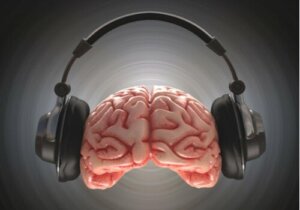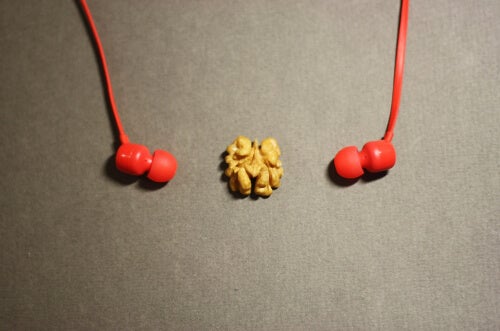Dichotic Listening and Selective Attention

Dichotic listening is a behavioral technique based on perceptual laterality that’s commonly used in neuropsychology. This technique is used during research on functional hemispheric specialization. That’s the relative predominance of one hemisphere or another for certain cognitive functions.
The left hemisphere specializes in language, and this hemisphere is responsible for grammatical processing and speech. Meanwhile, the right hemisphere is responsible for visuospatial processing, the perception of objects and faces.
What exactly is dichotic listening?
Dichotic listening is a technique based on the simultaneous presentation of two different auditory stimuli, one in each ear. The stimuli presented can vary from words to syllables, to letters, and even to musical sounds. In addition, other parameters might vary, such as the interval between and within stimuli, and the number of presentations and intensity.
In this technique, the projections of the auditory pathway to the motor cortex are ipsilateral and contralateral. Thus, the information received by each ear projects on both cerebral hemispheres. During dichotic listening, the ipsilateral pathways inhibit. Thus, the information received in one ear passes exclusively to the opposite cerebral hemisphere. It then happens that, if there’s an injury in any of the cerebral hemispheres, one can observe a deficit in the ear contralateral to the injury. All under a dichotic listening condition.
A standard dichotic listening test consists of a relatively high number of dichotic syllables. It’s a common result for the subject to identify a greater number of syllables in the right ear than the left. This is referred to as the right ear advantage (REA).

Characteristics
This advantage of the right ear is explained by Doreen Kimura under two assumptions. The first assumption is that, as mentioned above, the ipsilateral pathways inhibit. As a consequence, only the contralateral pathways remain functional. Moreover, clinical and neurophysiological evidence indicates that the language is present in the left hemisphere. At least that’s the case in most people.
Therefore, based on these conclusions, REA is due to the fact that the information received by the right ear travels a shorter and more direct path to the left hemisphere (contralateral pathways). Meanwhile, the information received by the left ear must travel the contralateral pathways to get to the right hemisphere. Then, they go through the transcellular pathway to the left hemisphere to be decoded from there. This affects the trace quality and results in responses with higher latency or with a greater number of errors.
Influence of attention on dichotic listening
Several authors have proposed that the REA obtained under dichotic listening could reflect other cognitive processes. Such processes are different from those related to language lateralization. Some of the suggested ones have been asymmetries in the interhemispheric activation or arousal, and memory and attentional effects, which are the most studied.

Dichotic listening applied to schizophrenia
Schizophrenia alters some cognitive functions such as attention, working memory, and executive functions. Thus, several studies revealed that people affected by schizophrenia have several common characteristics. Firstly, there’s a higher proportion of left-handers. In addition, there’s less asymmetry of the planum temporale and Silvian fissure or lateral sulcus. Also, there’s a decreased REA.
Applied to major affective disorders
Some facts about the study of visual and auditory lateralization applied to major affective disorders:
- People with melancholic depression show an exaggerated right ear advantage in comparison to healthy patients.
- The most exaggerated REA appears in the absence of anxiety.
- Patients with social phobia show lower REA than healthy patients.
Thus, it seems that melancholic depression has something to do with an exaggerated REA. While the spectrum of anxiety disorders has something to do with an insufficient REA.
Thus, you could also apply this technique to other pathologies. In fact, it’s often used with dyslexia or multiple sclerosis, for example. Its scope in neuropsychological practice is extensive.
Moreover, it’s a measure of the function of the temporal lobe and the corpus callosum, as well as selective attention and executive functions.
All cited sources were thoroughly reviewed by our team to ensure their quality, reliability, currency, and validity. The bibliography of this article was considered reliable and of academic or scientific accuracy.
- Pérez Cano, Miguel & García Martín, J (2018). Escucha dicótica. Retrieved from https://www.lpi.tel.uva.es/~nacho/docencia/ing_ond_1/trabajos_04_05/io1/public_html/dicoticaa.htm
-
Gadea-Doménech, M., & Espert-Tortajada, R. (2004). Aplicaciones de la escucha dicótica verbal a la clínica neurológica y neuropsiquiátrica. Rev Neurol, 39, 74-80.
-
Hugdahl, K. (1996). Brain laterality—beyond the basics. European Psychologist, 1(3), 206-220.
-
Kimura, D. (1961). Cerebral dominance and the perception of verbal stimuli. Canadian Journal of Psychology/Revue canadienne de psychologie, 15(3), 166.
-
Kimura, D. (1967). Functional asymmetry of the brain in dichotic listening. Cortex, 3(2), 163-178.
-
Mondor, T. A., & Bryden, M. P. (1991). The influence of attention on the dichotic REA. Neuropsychologia, 29(12), 1179-1190.
This text is provided for informational purposes only and does not replace consultation with a professional. If in doubt, consult your specialist.








